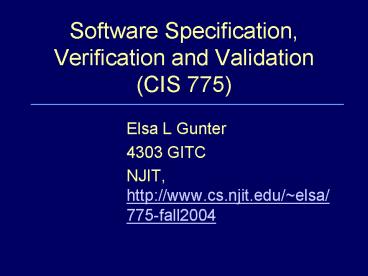Software Specification, Verification and Validation CIS 775 - PowerPoint PPT Presentation
1 / 22
Title:
Software Specification, Verification and Validation CIS 775
Description:
Dry run individually in my office. Elsa L. Gunter. Example topics. Project: ... Bob: I have just the solution for you. It would solve everything. Elsa L. Gunter ... – PowerPoint PPT presentation
Number of Views:42
Avg rating:3.0/5.0
Title: Software Specification, Verification and Validation CIS 775
1
Software Specification, Verification and
Validation (CIS 775)
- Elsa L Gunter
- 4303 GITC
- NJIT, http//www.cs.njit.edu/elsa/775-fall2004
2
Contact Information
- Office 4303 GITC
- Office hours
- Tuesdays 1130 230
- Thursdays by appointment
- Email elsa_at_cis.njit.edu
3
Course Structure
- Text Software Reliability Methods by Doron
Peled, Springer - Credit
- Homework 35 (submitted in class)
- Project or paper report 65
- Includes presentation of work
- Projects may be joint
- No Final Exam
4
Project or Paper Report
- Projects should
- Explore some examples using tools.
- Implement a simple algorithm.
- Papers should
- Deal with new material.
- Will post a list of suggested projects and a list
of possible papers - Can choose one of these, or propose something of
your choosing
5
Project or Paper Report
- Submit proposal by Monday 8 March
- Final Report due Monday 3 May
- 2-3 pages code, or 6-10 pages, typeset
- Presentations during finals week - by default at
time of final exam - We can negotiate it, but I want all present
- Dry run individually in my office
6
Example topics
- Project
- Verify some example using some tools.
- Communication protocols.
- Mutual exclusion.
- Implement algorithm
- Type checking
- Model checking algorithm
- Basic theorem prover
- Advanced topics
- Abstractions.
- Reductions.
- Partitions.
- Static analysis.
- Verifying pushdown automata.
- Verifying security protocols.
7
Goal software reliability
- Use software engineering methodologies to develop
the code.
- Use formal methods during code development
8
What are formal methods?
- Techniques for analyzing systems, based on some
mathematics. - This does not mean that the user must be a
mathematician. - Some of the work is done in an informal way, due
to complexity.
9
Examples for FM
- Deductive verificationUsing some logical
formalism, prove formally that the software
satisfies its specification. - Eg. Floyd - Hoare Logic
- Type checking
- Model checkingUse some software to
automatically check that the software satisfies
its specification. - TestingCheck executions of the software
according to some coverage scheme.
10
Typical situation
- Boss Mark, I want that the new internet
marketing software will be flawless. OK? - Mark Hmmm. Well, ..., Aham, Oh! Ah??? Where do I
start? - Bob I have just the solution for you. It would
solve everything.
11
Some concerns
- Which technique?
- Which tool?
- Which experts?
- What limitations?
- At which points?
- How expensive?
- How many people?
- Needed expertise?
- Kind of training?
- Size limitations?
- Exhaustiveness?
- Reliability?
- Expressiveness?
- Support?
12
Badmouth
- Formal methods can only be used by
mathematicians. - The verification process is itself prone to
errors, so why bother? - Using formal methods will slow down the project.
13
Some answers...
- Formal methods can only be used by
mathematicians. - Wrong. They are based on some math but the user
should not care. - The verification process is itself prone to
errors, so why bother? - We opt to reduce the errors, not eliminate them.
- Using formal methods will slow down the project.
- Maybe it will speed it up, once errors are found
earlier.
14
Some exaggerations
- Automatic verification can always find errors.
- Deductive verification can show that the software
is completely safe. - Testing is the only industrial practical method.
15
Our approach
- Learn several methods (deductive verification,
model checking, testing, process algebra). - Learn advantages and limitations, in order to
choose the right methods and tools. - Learn how to combine existing methods.
16
Emphasis
- The processSelecting the tools,
Modeling,Verification, Locating errors. - Use of toolsHands on. DOVE, Isabelle or HOL,
SPIN - Visual notationStatecharts, MSCs, UML.
17
Where do we start?
- Boss Mark, can you verify this for me?
- Mark OK, first I have to ...
18
Things to do
- Check the kind ofsoftware to analyze.
- Choose methods and tools.
- Express system properties.
- Model the software.
- Apply methods.
- Obtain verification results.
- Analyze results.
- Identify errors.
- Suggest correction.
19
Different types of software
- Software Kinds
- Sequential.
- Concurrent.
- Distributed.
- Reactive.
- Aspect Modeled
- Protocols.
- Abstract algorithms.
- Finite state.
20
SpecificationInformal, textual, visual
- The value of x will be between 1 and 5, until
some point where it will become 7. In any case it
will never be negative. - (1ltxlt5 U x7) /\ xgt0
X7
1ltxlt5
Xgt0
21
Verification methods
- Finite state machines. Apply model checking.
- Apply deductive verification (theorem proving).
- Program too big, too complicated.Apply testing
techniques. - Apply a combination of the above!
22
Modeling - Different Approaches
- Use the program text.
- Translate to a programming language embedded in
some proof system. - Translate to some notation (transition system).
- Translate to finite automata.
- Use visual notation.
- Special case black box system.































